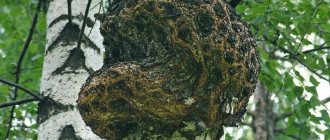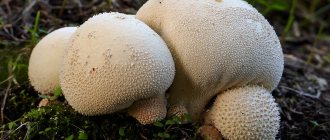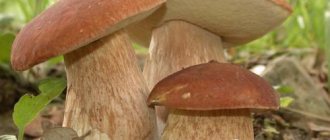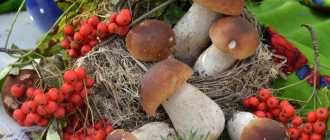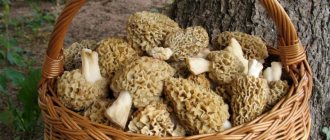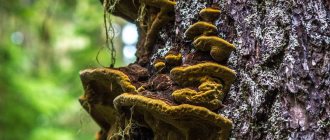Mushrooms grow both in spring and summer. However, in autumn, due to frequent wet weather, a large number of mushrooms grow.
You need to know what edible mushrooms are collected in September, as well as in October and November.
In the golden forests
The mushroom picking season does not end with the onset of September, the end of the era of warm summer rains and the arrival of rainy and chilly autumn. Autumn is the peak fruiting time for many popular types of edible mushrooms. Some species can be collected until the first snow cover falls.
In these glorious months of the gradual fading of the riot of nature, autumn honey mushrooms, golden and fleecy scales, boletus and aspen mushrooms, numerous rows, volushki and milk mushrooms, moss mushrooms, goat mushrooms, hedgehog mushrooms, Polish mushrooms, chestnut mushrooms, forest champignons, cystoderms and hygrophora grow. Finally, the king of mushrooms, the white boletus, continues to bear fruit until late autumn.
This article talks about what edible mushrooms grow in our forests in the fall.
Autumn honey fungus or True honey fungus Armillaria Mellea
Conventionally, an edible mushroom from the genus Honey fungus, family Physalacriaceae, is also known as Autumn Honey fungus. One of the most popular agaric mushrooms in Russia
Appearance
The cap is up to 10 cm in diameter, and occasionally up to 17 cm. In young specimens it is convex, then becomes flat, sometimes with wavy edges. The surface of the cap is covered with light sparse scales, which may disappear with age. The color of the cap is highly variable, it is assumed that it depends on the substrate on which the fruiting body grows. Those growing on poplar, white acacia, and mulberry have a honey-yellow shade of cap, on coniferous trees it is reddish-brown, on oak it is brown, and on elderberry it is gray.
The hymenophore is lamellar, the plates are attached to the stalk, or weakly running down it, sparse, in youth pale pink in color, later they become pinkish-brown, and may be covered with brown spots. Spore powder is white.
The leg is up to 10 cm long and up to 2 cm in diameter, yellow-brown in color, darker in the lower part. In the upper part there is a light membranous ring. The surface of the stalk is covered with flocculent scales; there is often a slight expansion at the bottom. In addition, the fruiting bodies are often fused with legs at the bottom.
The flesh in the cap is light and dense; in young specimens, it becomes thinner with age. The flesh in the stem is fibrous, becoming very coarse with age. It has a pleasant mushroom smell and taste.
Where and when does it grow
Autumn honey fungus is a parasitic fungus that lives on many types of plants - trees, shrubs and herbaceous plants. It usually bears fruit in large groups. It settles on weakened wood, causing white rot of the trunk. It can grow on already rotting wood, even fallen branches and cuttings of fallen leaves. Autumn honey fungus is famous for the fact that wood impregnated with its mycelium can glow in the dark with a faint white glow.
Armillaria Mellea is widespread throughout the Northern Hemisphere, except in the permafrost region. Prefers damp forests, slopes of ravines, places where deforestation took place.
It bears fruit from the end of August to the very beginning of winter, especially actively in the first half of September. Often appears in waves lasting 15–20 days.
Culinary use
Autumn honey mushrooms are extremely popular in Russia, in contrast to European countries, where they are almost never collected. It can cause eating disorders when consumed raw, so it is recommended to boil it first, although many lovers of this mushroom never do this. The pulp of this mushroom is tasty, but has a very dense structure and is difficult for the stomach to digest, so boiling it for 20 minutes will only benefit it. The mushroom is suitable for any type of culinary processing or storage for future use. The taste qualities of each individual specimen strongly depend on the place of growth, and on the age of the mushroom - as many variations of the area as there are variations of taste. In older specimens, the legs are too rigid and, as a rule, they are not collected. Common boletus Léccinum scábrum
Mushroom from the genus Leccinum, family Boletaceae. His names are also Obabok and Berezovik
Appearance
The cap is convex, initially hemispherical, then cushion-shaped, with a diameter of 6 to 15 cm. Its color can vary from light gray to dark brown depending on the growing conditions. The cap looks smooth, but in damp weather it becomes slightly slimy.
The tubular-looking plates, initially light, turn gray over time. Very easy to separate from the cap.
The leg is solid, cylindrical, up to 15 cm long and up to 3 cm in diameter. White-gray in color. The top is covered with a pattern of brownish scales, and the bottom has a slight widening.
The pulp is white when cut and does not change color after cutting. Very tasty and aromatic. The flesh of the leg is much tougher than that in the cap, but it is also quite edible and tasty.
Where and when does it grow
It bears fruit from early summer to early to mid-autumn, depending on the weather, in deciduous forests. As a rule, in the vicinity of birch trees, but not always necessarily. Sometimes it grows vigorously among young spruce forests, where there are only a couple of birches. Experienced mushroom pickers go for boletus mushrooms in mid-July, when they reach their peak form. Boletus is a very tasty mushroom, and not only people know about it. As a rule, autumn boletuses are already generously eaten by a diverse forest population.
It is found throughout Eurasia and the Americas. It even grows in the forest-tundra next to dwarf birches, and the local population calls them “overbirch trees” because there they are taller than the birches themselves.
When to pick purple autumn mushrooms
You may be interested in: How do edible talkers differ from false mushrooms? How many days after rain do mushrooms grow? Bitter mushroom: photo and detailed description
The forest products of the so-called purple group, which includes about 20 varieties, also deserve special attention. Its most common representative is the blueberry or violet row, which begins to bear fruit from early spring until mid-November. Its difference from other varieties lies in the gray cap and bright purple stem, which makes it possible not to confuse the mushroom with poisonous inhabitants of groves and meadows.
The pine boletus, growing in coniferous forests, also has a rich purple tint to the cap and you can go looking for it as early as mid-June. Soon the russula and the harsh boletus with its dark cap covered with numerous scales arrive.
Oyster mushrooms are also purple, however, in this case their color becomes not saturated, but dull and deep. You should go to collect these mushrooms no earlier than the end of October.
Well, the fruiting season of this group is closed by the cobweb, which has several purple varieties. Among them are blue-stemmed (the stem can be either gray or white), excellent (only the cap of the mushroom is colored lilac), red-olive (the cap of young fruits and the stem throughout the life cycle), and also violet (the brightest variety of the family , having a uniform color).
When picking mushrooms, you should not forget one important rule that every experienced mushroom picker adheres to. It lies in the fact that if the collector is not confident in the edibility of the fruit he finds, then he should not cut it, no matter how attractive it may look.
Red boletus Leccinum Aurantiacum
A mushroom from the genus Obabok, Boletaceae family, also known as Redhead and Common Boletus.
Appearance
The cap, up to 15 cm in diameter, initially has a spherical shape and is, as it were, stretched over a stem; subsequently it straightens. The cap is colored in orange-red shades and is covered with velvety skin, noticeably protruding at the edges. The color varies noticeably depending on the place of growth - in pure aspen forests it is dark red, in mixed ones it is yellow-red or orange, in poplar forests it has a gray tint.
The hymenophore is tubular-type, the tubes are free, with small angular-rounded pores, initially white, over time they become brownish-gray or yellow. Darkens when touched. Spore powder is olive-brown.
The leg is weighty, up to 15 cm high and up to 5 cm thick, often widening at the bottom. The stem is colored in grayish-white shades and is covered with longitudinal fibrous scales, initially light and darkening as the mushroom matures.
The pulp is fleshy, longitudinally fibrous in the stem and dense, softening with age, in the cap. The pulp is white, with a bluish tint at the bottom of the stem, turns blue when cut, then turns black. It has no pronounced taste or smell.
Where and when does it grow
Fruits from June to October, in three characteristic waves - “spikes” - from the end of June to the first days of July, this wave is not very abundant in quantity, then, much more abundant, “stubbers” - from mid-July, and, finally, “deciduous " - from mid-August to mid-September - this wave is the longest and most numerous. Between the waves, and, in late autumn, until mid-October, there follows a decline, when only isolated specimens of boletuses are found in the forests. The drier the summer, the more noticeable the boundaries between the waves of fruiting; in rainy years, the boundaries between them are much more blurred.
Red boletus forms mycorrhiza with a variety of deciduous trees, most commonly aspen and poplar, but also with willow, hornbeam, birch, beech and oak. It bears fruit in small groups in mixed and deciduous forests, but if you're lucky, it covers huge clearings.
Culinary use
Boletus is one of the most popular edible mushrooms, comparable in its nutritional value to Boletus, and suitable for any type of culinary use. In Western Europe, due to the fibrous nature of the legs, it is recommended to eat only the caps; in Russia, they usually eat the whole thing.
White volnushka Lactarius Pubescens
A very good mushroom with a wonderful taste, highly valued by collectors, most often used for pickling and pickling. Also known by the names Volzhanka and Belyanka.
Appearance
The cap, up to 8 cm in diameter, is initially convex in shape, later becoming prostrate and funnel-shaped, depressed in the center and with a curled edge. It has a whitish color, lighter at the edges, and is covered with a thick velvety edge, sometimes slightly mucous. With age, the cap becomes smoother and turns yellow.
The hymenophore is lamellar, the plates are white, slightly descending, narrow and frequent. They turn yellow with age. Spore powder is cream or white.
The leg can be of different heights, depending on the habitat. In specimens grown among dense tall grass, it can be up to 8 cm long; in those growing in a bare open place, it is much shorter - up to 4 cm. The thickness of the leg reaches 2 cm, it is smooth or slightly pubescent, has a cylindrical shape and tapers downward. Colored similarly to the cap.
The pulp is white and brittle, with a faint odor. Produces a caustic milky juice.
Where and when does it grow
It grows in mixed and deciduous forests, forms mycorrhiza with birch, so it is often found in birch forests. Loves dampness and slightly marshy places. Fruits in large groups from early August to early October.
Culinary use
The mushroom is very tasty, but its flesh is naturally very bitter, so White Volnushka must be soaked in clean water for several hours and then boiled for at least 20 minutes. If the mushroom is undercooked, it will taste bitter even when pickled. Volnushka is usually used for pickling and salting, but it is also suitable for frying.
Similar species
- Burnt tinder fungus
In fact, this is not even a species, but a complex of species, consisting of several varieties of polypores, similar in appearance and growing on willows, which distinguishes them from the oak polypore. In addition, the edge of old mushrooms really looks like wood burned to the state of charcoal.
Grows exclusively on coniferous trees. In addition, its pulp when broken has a characteristic shine.
Pink Bluethroat Lactarius Torminosus
Another very popular mushroom, often used for harvesting for future use. It has many alternative names - Volnukha, Rubella, Volnyanka, Volzhanka, etc.
Appearance
The hat, up to 12 cm in diameter, is initially convex in shape, then becomes flat, with a deep depression in the center and the edges turned down. The skin of the cap is slightly slimy and covered with small velvety fibers arranged in characteristic concentric circles. It has a soft pink, gray-pink, yellow-orange color, and can fade to almost white with age. It starts to darken when touched.
The hymenophore is lamellar, the plates are not wide and frequent, having intermediate plates and descending along the stalk. They have a light or slightly pinkish color, turning yellow with age. Spore powder is cream or white.
The leg is up to 6 cm high and up to 2 cm in diameter, cylindrical in shape, slightly tapering towards the base, dense and strong. It has a pale pink color and is covered with a small edge.
The pulp is dense and white, with a faint resinous odor and pungent taste. Produces an acrid white milky juice.
Where and when does it grow
It grows from June to October in birch groves or forests mixed with birch. Loves moisture, distributed mainly in the northern part of the forest zone. It forms mycorrhiza with birch, and mainly with mature trees. It bears fruit in small groups; the fruiting season is the end of July and the end of August. According to the observations of collectors, this species is especially loved by worms.
Culinary use
Volnushki are traditionally used for salting and pickling, although they are also suitable for frying. For pickling, “curls” are usually used - very young fruiting bodies, with a cap diameter of no more than 4 cm. Salted volushki are suitable for food two weeks after salting. The problem with bitter taste is solved by long soaking - up to 3 days, with periodic changes of water, as well as preliminary boiling for at least 20 minutes, or blanching - scalding with boiling water. In the north of Russia, trumpet mushrooms hold one of the first places among the types of mushrooms harvested for the winter.
There are several more types of Milkies, which are called Volnushki
Secrets of salting and marinating + pictures
All mushrooms can be preserved in salted form, but lamellar ones are better: tubular ones are unsightly in appearance. In addition, under the influence of salt, their value and taste decrease. But the bitterness decreases when soaked, and disappears completely when salted.
Salting methods:
- cold;
- hot.
First, they are divided by type, since the soaking period is different for everyone (milk mushrooms - 2-3 days, volushki - a day, saffron milk caps are not soaked). With the hot method, milk mushrooms and podgruzdki are cooked for up to 10 minutes, skripitsa and valui for half an hour. As for russula, russula, whitefish, and greenfinches, they are blanched for 7 minutes. It is enough to pour boiling water over the saffron milk caps several times, or it is better to salt them dry, sprinkling each layer of mushrooms, placed caps down, with salt (30 g per 1 kg). Remember: spices make saffron milk caps darken.
Boletus, honey mushrooms, saffron milk caps, boletus mushrooms, and porcini mushrooms are good for pickling. Divided into types and sizes, saffron milk caps are immersed in boiling water for about 4 minutes, aspen and boletus mushrooms are poured with boiling water, kept in it for 5-10 minutes and doused with cold water (the marinade will not turn black). Chanterelles and valui are boiled in lightly salted water for 20-25 minutes, washed and boiled again with vinegar and salt.
Ryadovka Gray, Tricholoma portentosum or Ryadovka Hatched
Edible mushroom from the genus Ryadovok, family Ryadovkov. It is highly valued by amateurs for its good taste and unprecedented frost resistance - this mushroom bears fruit in the fall until the hardest frosts, when there is almost nothing else to collect besides it. Gray Ryadovki, for their color and friendship with pine, are popularly called mice, serushkas and pine trees.
Appearance
The cap is fleshy, up to 10-12 cm in diameter, in young specimens it is convex, rounded - conical, with a tucked edge, in mature specimens it is flat - spread out and uneven, with a small flat tubercle in the center, and a straightened wavy edge with cracks. The cap is colored dark gray or pale gray, often with purple tones, the center is always lighter than the edges. Dark radial fibers are clearly visible on top of it. The surface of the cap is dry and smooth to the touch; in damp weather it becomes covered with mucus, and pine needles and forest debris stick to it abundantly. In old age, the cap can become very cracked.
The hymenophore is lamellar, the plates are wide, sparsely spaced and slightly tortuous, weakly adherent. In young specimens they are white, in mature ones they are gray, with a slightly greenish-yellowish tint. Spore powder is white.
The leg is dense and smooth, longitudinally fibrous, up to 2 cm thick and 10–15 cm long, although, usually, it is half buried in the forest litter, cylindrical, with a slight thickening at the base. Initially, the leg is solid, but with age, a cavity forms inside it. The shade of the leg is from grayish-white to lemon-yellowish; on top it is sometimes covered with a fibrous-mealy coating.
The pulp is dense, white-grayish in color in the cap, and fibrous, more yellowish in the stem; at the break the yellowness is even more pronounced.
The pulp has a pleasant sweetish taste and a faint but wonderful smell of fresh flour. In older specimens, the smell becomes more rancid and unpleasant.
Where and When It Grows
Tricholoma portentosum grows in coniferous, most often pine, forests. It combines mycorrhiza with pine, which is why it is usually found next to it, hence the popular name - pine. Sometimes Ryadovka Gray can be found in mixed forests, but, again, in the vicinity of pine trees. It bears fruit on sandy soils, in mosses, under coniferous and deciduous litter. Often, on the surface of the litter, under the pine trees, only small bulges are noticeable, and in order to find the familiar gray caps, you need to carefully stir it up. The Gray Ryadovka is found in groups, or “witch circles,” or less often alone.
This is an autumn mushroom, bearing fruit from early September to late November. The best season is the end of September – the first half of October. Ryadovka Gray is widespread throughout the temperate zone of the Northern Hemisphere. In the south of Russia it can bear fruit until December, and in the central part it lasts “until the last”, until very severe frosts occur. This mushroom is famous for the fact that it easily recovers after slight frosts without losing its taste.
Culinary value
Ryadovka Gray is an excellent edible mushroom, but it requires a little pre-treatment - it needs to be soaked for 15 - 20 minutes, and then boiled for 20 minutes, after first removing the skin from the cap. When cooked, the flesh of this mushroom acquires a chestnut-gray color.
After boiling, Gray Ryadovka is suitable for any culinary processing and preparation for future use. However, many lovers of mouse mushrooms do not recommend soaking them before cooking, assuring that this deprives the mushrooms of their full taste.
"Chicken meat"
Outwardly, this yellow-orange growth really resembles a piece of homemade chicken. This is a parasitic fungus that can grow anywhere, but is most often found on oak trees. Massive growth of chicken mushrooms is observed in the fall, and at this time they reach very large sizes.
To detect “chicken meat”, you do not need to bend down to the ground, but look up, because these mushrooms grow on trunks quite high. There is no need to cook them. The tastiest of them are chopped cutlets and chops.
I recently discovered a chicken mushroom on a pear tree that grows outside the site. If such a growth appears on a branch, it must be cut below the mushroom, because it will eat everything higher. The mycelium destroys wood, and if the fungus is not removed immediately, the entire tree may die.
Gruzd Black
Black Breast Lactarius Necator is a mushroom from the genus Milky, the Russula family, known under many popular names - Nigella, Gypsy or Chernysh.
Appearance
The cap is up to 20 cm in diameter, flat-shaped, depressed in the center, sometimes widely funnel-shaped with a felt edge turned inward. The skin on the cap is dark olive in color, with barely noticeable concentric zones. The color palette of the cap can vary from dark olive and yellowish-brown to dark brown. The surface of the cap is slimy or sticky in wet weather.
The hymenophore is lamellar, the plates descending along the stalk, thin and frequent, forked-branched. Spore powder is pale cream in color.
The leg is up to 8 cm high and up to 3 cm in diameter, mucous and smooth, sometimes has depressions on the upper surface. The stem, most often, is the same color as the cap, sometimes a little lighter in the upper part; in young fruiting bodies it is solid, but over time, a cavity forms in it.
The pulp is dense and brittle, white in color, turning gray when cut. It produces abundant white milky juice, which has an extremely pungent taste.
Where and when does it grow
This species grows from mid-July to mid-October in mixed forests, in mosses and forest litter, in grass along the sides of forest roads, in light forest clearings. Usually found in large, close groups. Peak fruiting of black milk mushrooms occurs from mid-August to late September.
Culinary use
This mushroom belongs to the category of conditionally edible and is considered edible only after preliminary soaking and boiling. Usually eaten fresh or salted. When salted, it tends to turn purple-burgundy. The mushroom must be soaked to remove the caustic milky juice.
Golden scale Pholiota Aurivella
A mushroom from the genus Scaly, the Strophariaceae family, often called the Royal Honey Mushroom.
Appearance
The cap is up to 18 cm in diameter, broadly bell-shaped, later flat-round. It has a rusty-yellow surface with reddish flaky scales.
The hymenophore is lamellar, the plates are wide, attached to the stalk with a tooth, straw-yellow in color in young specimens and brown in mature ones.
The leg is up to 10 cm high and up to 1.5 cm in diameter, dense, brown-yellow in color, covered with brown scales on top. There is a fibrous ring on the stalk, which often falls off with age.
The pulp is yellowish in color, without a distinct smell or taste.
Where and when does it grow
Grows from late spring to mid-autumn, on dead wood, in deciduous forests.
Culinary use
A good edible mushroom, suitable for all types of culinary processing and storage for future use. The pulp of this species is especially rich in amino acids beneficial to the human body.
Chemical composition
Pine pine has a fairly rich chemical composition and is a source of useful substances for the human and animal body. It includes:
- vitamins A, K, C, PP, D2, D7, group B;
- glucose;
- calcium;
- magnesium;
- zinc;
- selenium;
- potassium;
- sodium;
- iron;
- manganese;
- copper;
- phosphorus;
- phenolic compounds;
- steroids;
- amino acids;
- flavonoids.
Forest Champignon Agaricus Sylvaticus
A mushroom from the Champignon genus, Champignonaceae family, also known as Blagushka.
Appearance
The cap is up to 12 cm in diameter, initially dome-shaped, then expands until it becomes almost flat. In adults, the edge of the cap may be slightly curled, sometimes with small pieces of the private spathe. The upper surface of the cap is colored in light reddish-brown shades, more ocher in the center and lighter at the edges, on top it is covered with reddish-brown concentrically arranged fibrous scales, smaller and denser in the center, and larger at the edges. In dry weather, cracks appear in the pulp.
The hymenophore is lamellar, the plates are often and freely located, with small additional plates. When young they are whitish-cream in color, then they become reddish-pink and gradually darken, up to a reddish-brown color. Spore powder is chocolate brown.
The leg is up to 10 cm high and up to 1.5 cm in diameter, slightly curved or smooth, with a slight thickening at the base. Colored in off-white or whitish-brown shades. Above the ring it is smooth, below the ring it is covered with small brown scales, smaller on top and larger in the lower part. In the oldest specimens, a cavity forms inside the stalk. On the stem there is a thin, and rather fragile, membranous ring, light in color, the upper part of which often turns red due to spilled spore powder.
The pulp is in the cap, thin and dense, in the stem it is fibrous, and turns red when cut. It has a mild taste and a pleasant mushroom aroma.
Where and when does it grow
It bears fruit from July to the end of November, singly or in groups, sometimes forming “witch circles.” It prefers coniferous and mixed forests, but also grows in deciduous ones, often found in parks and on the edges of forests.
Culinary use
An excellent edible mushroom, suitable for any type of culinary use. A peculiarity of this type is the absence of a pronounced mushroom taste, which is appreciated for preparing dishes where this taste should not interrupt the taste of other ingredients.
Autumn days can be as sunny and welcoming as summer ones, and persistent experts on quiet hunting still comb our forests in search of numerous species of autumn mushrooms that will delight them with their appearance right up to winter.


